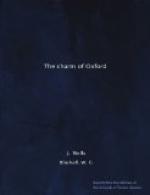While it is true that the pre-eminence of Balliol is a growth of the nineteenth century, yet the college can count among its worthies one of the greatest names in English mediaeval history, that of John Wycliffe. He was probably a scholar of Balliol, and certainly Master for some years about 1360. But he left the college for a country living, and his time at Balliol is not associated with either of his most important works—his translation of the Bible or his order of “Poor Preachers.” While at Balliol, he was rather “the last of the Schoolmen” than “the first of the Reformers.”
The modern greatness of Balliol is due to the fact that the college awoke more rapidly from the sleep of the eighteenth century than most of Oxford, and as early as 1828 threw open its scholarships to free competition. Hence even as early as the time of Dr. Arnold at Rugby, a “Balliol scholarship” had become “the blue riband of public-school education.” It has now passed into popular phraseology to such an extent that lady novelists, unversed in academic niceties, confer a “Balliol scholarship” on their heroes, even when entering Cambridge.
Balliol has known how to take full advantage of its opportunity. Governed by a series of eminent masters, especially Dr. Scott of Greek dictionary fame, and Professor Jowett, the translator of Plato and the hero of more Oxford stories than any other man, it has been ready to adapt itself to every new movement. While the governing bodies of other colleges in the middle of the last century were too often looking only to raising their own fellowships to the highest possible point, the Balliol dons were denying their own pockets to enrich and strengthen their college.
Hence, undoubtedly, Balliol for a long time past has had a lion’s share of Oxford’s great men; two Archbishops of Canterbury, Tait and Temple, the present Archbishop of York, Cardinal Manning, a Prime Minister in Mr. Asquith, a Speaker in Lord. Peel, two Viceroys of India in Lord Lansdowne and Lord Curzon, poets like Clough, Matthew Arnold and Swinburne, these are only some of the more outstanding names. It is this which makes Balliol Hall so particularly interesting to the ordinary man; knowledge of present-day affairs, not of history, is all that is needed to appreciate its array of portraits.
Nor has Balliol been unmindful of the social movements of our time. It is the chosen home of the Workers’ Educational Association in Oxford, and in Arnold Toynbee it produced one of the pioneers and martyrs of modern social progress. Truly Balliol has much more to show to the visitor than its ultra-modern front on the Broad would promise.
The street, on which Balliol looks out, is associated with the most famous scene of Oxford history; the stone with a cross in the middle of the road marks the traditional site of the burning of the bishops, Cranmer, Ridley, and Latimer, although their memorial has been erected 200 yards further north in St. Giles’, and though antiquarians argue (probably correctly) that the actual pyre was a little further south, in fact, behind the present row of Broad Street houses.




